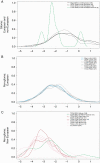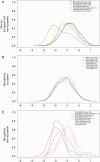Inherited genetics of adult diffuse glioma and polygenic risk scores-a review
- PMID: 35859544
- PMCID: PMC9290891
- DOI: 10.1093/nop/npac017
Inherited genetics of adult diffuse glioma and polygenic risk scores-a review
Abstract
Knowledge about inherited and acquired genetics of adult diffuse glioma has expanded significantly over the past decade. Genomewide association studies (GWAS) stratified by histologic subtype identified six germline variants that were associated specifically with glioblastoma (GBM) and 12 that were associated with lower grade glioma. A GWAS performed using the 2016 WHO criteria, stratifying patients by IDH mutation and 1p/19q codeletion (as well as TERT promoter mutation), discovered that many of the known variants are associated with specific WHO glioma subtypes. In addition, the GWAS stratified by molecular group identified two additional novel regions: variants in D2HGDH that were associated with tumors that had an IDH mutation and a variant near FAM20C that was associated with tumors that had both IDH mutation and 1p/19q codeletion. The results of these germline associations have been used to calculate polygenic risk scores, from which to estimate relative and absolute risk of overall glioma and risk of specific glioma subtypes. We will review the concept of polygenic risk models and their potential clinical utility, as well as discuss the published adult diffuse glioma polygenic risk models. To date, these prior genetic studies have been done on European populations. Using the published glioma polygenic risk model, we show that the genetic associations published to date do not generalize across genetic ancestries, demonstrating that genetic studies need to be done on more diverse populations.
Keywords: genetics; glioma; polygenic; risk; variants.
© The Author(s) 2022. Published by Oxford University Press on behalf of the Society for Neuro-Oncology and the European Association of Neuro-Oncology. All rights reserved. For permissions, please e-mail: journals.permissions@oup.com.
Figures





References
-
- Louis DN, Perry A, Reifenberger G, et al. . The 2016 World Health Organization Classification of Tumors of the Central Nervous System: a summary. Acta Neuropathol. 2016;131:803–820. - PubMed
Publication types
Grants and funding
LinkOut - more resources
Full Text Sources
Miscellaneous

